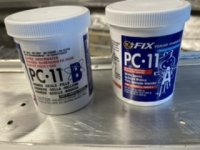Honestly, I should modify my previous comment. My main concern with a pit is if it's large enough to cause the base metal to be weak. Since there are holes all through the boat, if it's not at a riveted joint or an obvious high stress path, it probably won't be a concern.
The second issue is corrosion likes crevices, so it creates a spot for further corrosion. This is where I would want to seal it or treat it. Epoxy will seal it, but even flex coatings could possibly peel, allowing moisture to be trapped underneath.
A chemical coating may possibly be better if it passivates the aluminum itself. I think alodine is commonly used for that, but I have zero experience. Zinc chromate primer is used as it will preferentially corrode rather than the aluminum underneath. I don't know how either perform in existing pits.
In my boat, the pits I filled were all the way through, and at the knee brace rivets. I decided to fill with jb weld and patch on both sides. That was just to help seal, the 5200 on the patches does most of the job however. I don't know that I would trust jb weld on its own.
Take my ramblings as things to think about rather than clear paths forward.















